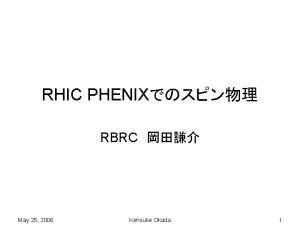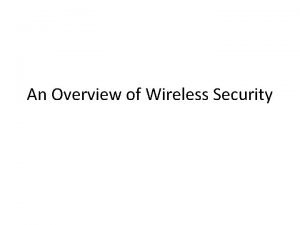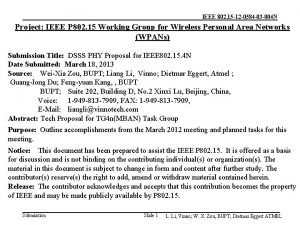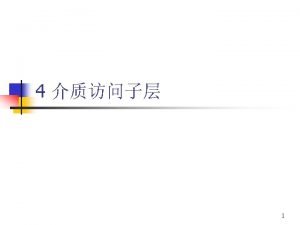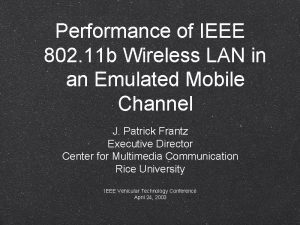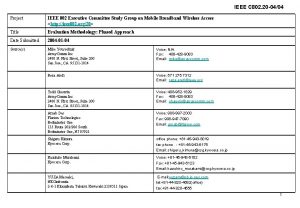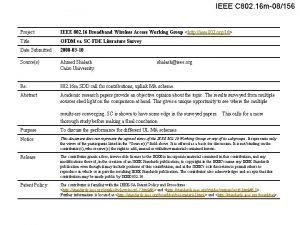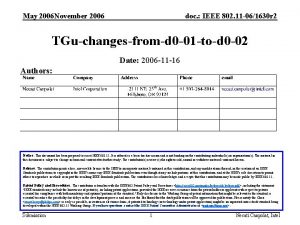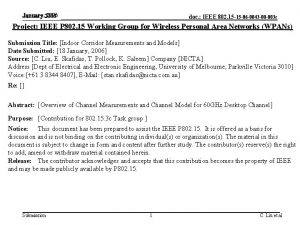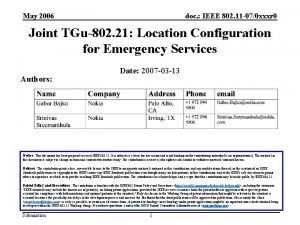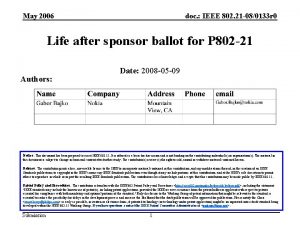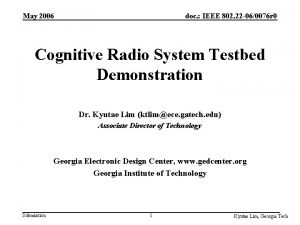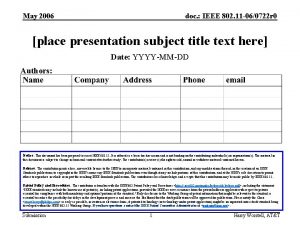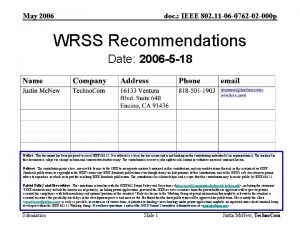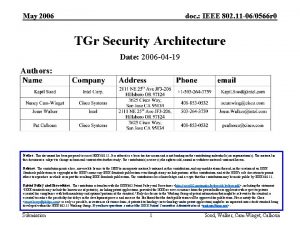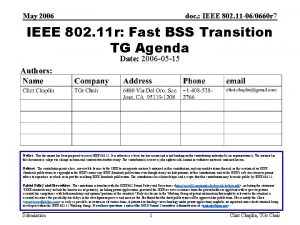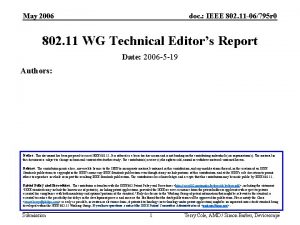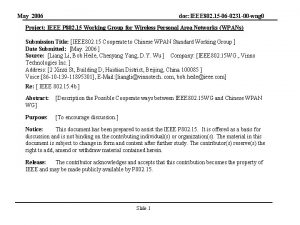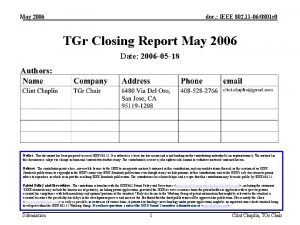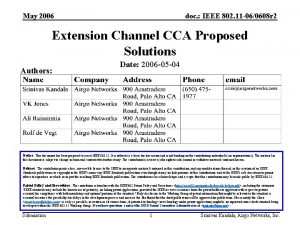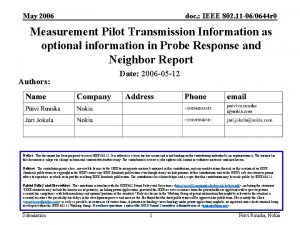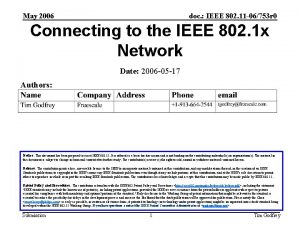May 2006 doc IEEE 802 11 060657 r




















- Slides: 20

May 2006 doc. : IEEE 802. 11 -06/0657 r 2 MAC improvement using random AIFSN Date: 2006 -05 -13 Authors: Notice: This document has been prepared to assist IEEE 802. 11. It is offered as a basis for discussion and is not binding on the contributing individual(s) or organization(s). The material in this document is subject to change in form and content after further study. The contributor(s) reserve(s) the right to add, amend or withdraw material contained herein. Release: The contributor grants a free, irrevocable license to the IEEE to incorporate material contained in this contribution, and any modifications thereof, in the creation of an IEEE Standards publication; to copyright in the IEEE’s name any IEEE Standards publication even though it may include portions of this contribution; and at the IEEE’s sole discretion to permit others to reproduce in whole or in part the resulting IEEE Standards publication. The contributor also acknowledges and accepts that this contribution may be made public by IEEE 802. 11. Patent Policy and Procedures: The contributor is familiar with the IEEE 802 Patent Policy and Procedures <http: // ieee 802. org/guides/bylaws/sb-bylaws. pdf>, including the statement "IEEE standards may include the known use of patent(s), including patent applications, provided the IEEE receives assurance from the patent holder or applicant with respect to patents essential for compliance with both mandatory and optional portions of the standard. " Early disclosure to the Working Group of patent information that might be relevant to the standard is essential to reduce the possibility for delays in the development process and increase the likelihood that the draft publication will be approved for publication. Please notify the Chair <stuart. kerry@philips. com> as early as possible, in written or electronic form, if patented technology (or technology under patent application) might be incorporated into a draft standard being developed within the IEEE 802. 11 Working Group. If you have questions, contact the IEEE Patent Committee Administrator at <patcom@ieee. org>. Submission 1 Todor Cooklev

May 2006 doc. : IEEE 802. 11 -06/0657 r 2 Abstract We discuss contention among streams of equal priority in the digital home. Next, we propose the use of random AIFSN as a solution, with draft text. Simulation results indicating the performance improvement are also included. The proposed scheme performs especially well under heavy channel loads. Submission 2 Todor Cooklev

May 2006 doc. : IEEE 802. 11 -06/0657 r 2 Outline • • Contention in 802. 11 scenarios for digital home Current 802. 11 e channel access mechanism Importance of AIFSN Why is random AIFSN better than fixed? Proposed channel access mechanism Simulation results Implementation considerations Conclusions Submission 3 Todor Cooklev

May 2006 doc. : IEEE 802. 11 -06/0657 r 2 Contention in 802. 11 scenarios for digital home • Many traffic streams anticipated in CE dominated home… – HD Video • Support for 4 -5 HD video streams 100 -125 Mbps • Content: Premium, time-shifted, DVD, personal, Gaming – Voice • Up to 4 streams with tight delay constraints – low throughput – Best-effort • Web, file transfer, printing - 10 Mbps • Contention among equal-priority traffic is an important issue Submission 4 Todor Cooklev

May 2006 doc. : IEEE 802. 11 -06/0657 r 2 Digital home of the future HD content V 4 HDTV V 1 V 3 V 2 Live or time-shifted Premium HD content Voice 3 -4 Data 2 -3 STB / PVR Cable, Satellite over WLAN Internet, IPTV V 5 Submission Personal content Media PC 5 Todor Cooklev

May 2006 doc. : IEEE 802. 11 -06/0657 r 2 802. 11 e channel access mechanism • Arbitration inter-frame space (AIFS) is one of the EDCA parameters used to ensure traffic differentiation • Each AC has fixed AIFS duration associated with it. The smaller the AIFS the higher the medium access priority • But multiple streams of the same AC use same AIFSN leading to increased collision! Fig. 1 EDCA channel access mechanism Fig. 2 From Table 20. 2 of 11 e Submission 6 Todor Cooklev

May 2006 doc. : IEEE 802. 11 -06/0657 r 2 AIFSN is important! • (from doc. 11 -06 -0654, Qualcomm) AIFS is – Effective in providing exclusive access to high priority stations under heavily loaded scenarios – Depletes channel access to low priority stations in heavily loaded scenarios Submission 7 Todor Cooklev

May 2006 doc. : IEEE 802. 11 -06/0657 r 2 Impact of EDCA AIFS parameter (from doc. 11 -06 -0654, Qualcomm) • Scenario – • • 1 AP with 4 STAs; STA 1 is the reference. AIFS of STA 1, 2 3, 4 set to [3, 4, 5, 6] , [4 5 6 7] respectively. [CWmin CWmax] = [15, 31] for all STAs. • Small differences in AIFS cause large discrepancies between flows • Therefore it is important to adjust the AIFSN!! Submission 8 Todor Cooklev

May 2006 doc. : IEEE 802. 11 -06/0657 r 2 How effective is adjusting the AIFSN? (assuming that AIFSN is fixed per AC) • Compare the following two scenarios with CWmin=7 and CWmax=15, AC 2 – Scenario I: For each QSTA AIFSN=2. – Scenario II: For each QSTA AIFSN=3. identical in both cases! • Therefore fixed AIFSN for all stations at the same AC does not help! • The probability for collisions is Submission 9 Todor Cooklev

May 2006 doc. : IEEE 802. 11 -06/0657 r 2 Proposed channel access mechanism – AIFSN is random with uniform probability density function in [2 3]. – On average, for 5 QSTA AIFSN=2 and for another 5 QSTA AIFSN=3. • Advantages – THE COLLISION PROBABILITY IS REDUCED! – Possible to assign an AC a non-integer AIFSN value on an average Submission 10 Todor Cooklev

May 2006 doc. : IEEE 802. 11 -06/0657 r 2 Simulation Results with TGn. Sync OPNET Model Average Retransmissions by N 4 2 x 2 MIMO, 20 MHz Channel, Offered load = 15 Mbps/node Fixed AIFSN = 2 Fixed AIFSN = 3 Random AIFSN [2, 3] CWmin = 7, CWmax = 15 Submission 11 Todor Cooklev

May 2006 doc. : IEEE 802. 11 -06/0657 r 2 Simulation Results with TGn. Sync OPNET Model Average Delay at N 5 Fixed AIFSN = 3 Fixed AIFSN = 2 Average Throughput at N 5 Random AIFSN [2, 3] Fixed AIFSN = 2 Fixed AIFSN = 3 Submission 12 Todor Cooklev

May 2006 doc. : IEEE 802. 11 -06/0657 r 2 How are other ACs affected? • Two scenarios for AC 2 – fixed AIFSN vs. random AIFSN 1. 10 QSTA, all in AC 2, each with fixed AIFSN 2. 5 QSTA, with AIFSN=2 and 5 QSTA with AIFSN=3 (on average), all 10 QSTA in AC 2 • Which scenario is better for QSTA belonging to other ACs? - Scenario 2 because: – Reduced collisions leads to better bandwidth utilization, which helps all QSTA! Submission 13 Todor Cooklev

May 2006 doc. : IEEE 802. 11 -06/0657 r 2 Simulation results with random AIFSN [2] • Simulation Parameters – – 2 x 2 MIMO, 20 MHz Channel, 5 pairs each of BE, Video and Voice traffic AIFSN[AC 1] – fixed default values as in Table 20. 2, except for video; AIFSN for video is random with uniform distribution over [1 3]. Delay per stream Throughput per stream Submission Best Effort Video Voice 14 Todor Cooklev

May 2006 doc. : IEEE 802. 11 -06/0657 r 2 Simulation results with random AIFSN • Simulation Parameters – – 54 Mbps PHY (802. 11 g), 4 pairs each for BE, Video and Voice traffic AIFSN[AC 1] – fixed default values as in Table 20. 2, except for video; AIFSN for video is random with uniform distribution over [2 4]. Global Delay per AC Global Throughput per AC Submission Best Effort Video Voice 15 Todor Cooklev

May 2006 doc. : IEEE 802. 11 -06/0657 r 2 Proposed Text : Section 9. 2. 3. 4 • Original… A Non-AP QSTA computes the time periods for each AIFS[AC] from the dot 11 EDCATable. AIFSN attributes in the MIB. QSTAs update their dot 11 EDCATable. AIFSN values using information in the most recent EDCA Parameter Set element of Beacons received from the QAP of the QBSS (see 7. 3. 2. 14). A QAP computes the time periods for each AIFS[AC] from the dot 11 QAPEDCATable. AIFSN attributes in its MIB. • NEW… Non-AP QSTA compute AIFSN[AC] using some probability density function over a finite interval. This interval is bounded on one side by the default values in Table 20. 2. The other limit of this interval is from the dot 11 EDCATable. AIFSN attributes in the MIB. QSTAs update their dot 11 EDCATable. AIFSN values using information in the most recent EDCA Parameter Set element of Beacons received from the QAP of the QBSS (see 7. 3. 2. 14). Submission 16 Todor Cooklev

May 2006 doc. : IEEE 802. 11 -06/0657 r 2 Proposed Text : Section 9. 9. 1. 3 • Original … The value of AIFSN[AC] shall be greater than or equal to 2 for non-AP QSTAs and is advertised by the QAP in the EDCA Parameter Set Information Element in Beacons and Probe Response frames transmitted by the QAP. The value of AIFSN[AC] shall be greater than or equal to 1 for QAPs. • NEW… QSTAs select the value of AIFSN according to some probability density function (PDF) over a finite interval. One of these limits (either the lower or the upper limit) is the default value specified in Table 20. 2. The other limit is in the dot 11 EDCATable. AIFSN attribute in the MIB. Any PDF is acceptable, including a PDF where QSTA always select one number that belongs to this interval. The limit value AIFSN[AC] is advertised by the QAP in the EDCA Parameter Set Information Element in Beacons and Probe Response frames transmitted by the QAP. If this limit value is smaller than the default values in Table 20. 2, then it becomes the lower bound of the interval. If this limit value is higher than the default values in Table 20. 2, then it becomes the higher bound of the interval. Submission 17 Todor Cooklev

May 2006 doc. : IEEE 802. 11 -06/0657 r 2 AIFSN intervals per AC The limit value specified by the AP could be higher or lower Submission 18 Todor Cooklev

May 2006 doc. : IEEE 802. 11 -06/0657 r 2 Implementation Issues • The suggested operation is mandatory, so that it will not get advertised in beacons and probe responses. • Since any probability density function is acceptable, all current implementations using fixed AIFSN comply with this proposal, i. e. no change is necessary. • Those that do want to change and implement, for example, uniform probability density function, will not only see an improvement in their throughput, but will improve overall network performance. • Fairness? The improvement according to the proposed scheme does not come at the expense of degradation somewhere else. The performance of the entire network is improved. Submission 19 Todor Cooklev

May 2006 doc. : IEEE 802. 11 -06/0657 r 2 Conclusions • Contention in wireless home scenarios is significant for equal-priority streams • The proposed random-AIFSN has benefit to all traffic classes – throughput increases and delay decreases • While the proposal is to make the suggested scheme mandatory, in reality it is optional because all current implementations comply with it. Submission 20 Todor Cooklev
 Bridges from 802.x to 802.y
Bridges from 802.x to 802.y Bridges from 802.x to 802.y
Bridges from 802.x to 802.y Ieee 802 family
Ieee 802 family Ieee 802 3 compliance
Ieee 802 3 compliance Wlan standards
Wlan standards Arquitetura ieee 802
Arquitetura ieee 802 El 802
El 802 Ieee 802 standard
Ieee 802 standard 802 15
802 15 802 ieee
802 ieee Ieee 802
Ieee 802 May 25 2006
May 25 2006 2006 mothers day
2006 mothers day Deped school calendar 2005-2006
Deped school calendar 2005-2006 Hci patterns
Hci patterns 802-11-wireless-security
802-11-wireless-security 802 15
802 15 Bus topology
Bus topology 802 11 b
802 11 b 802 20
802 20 802 16
802 16











